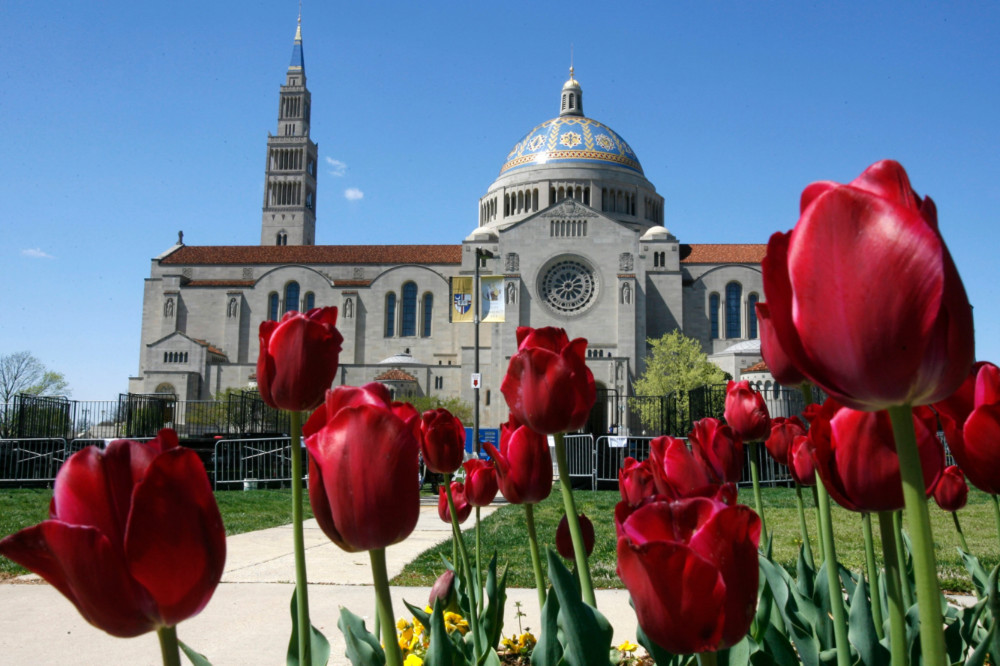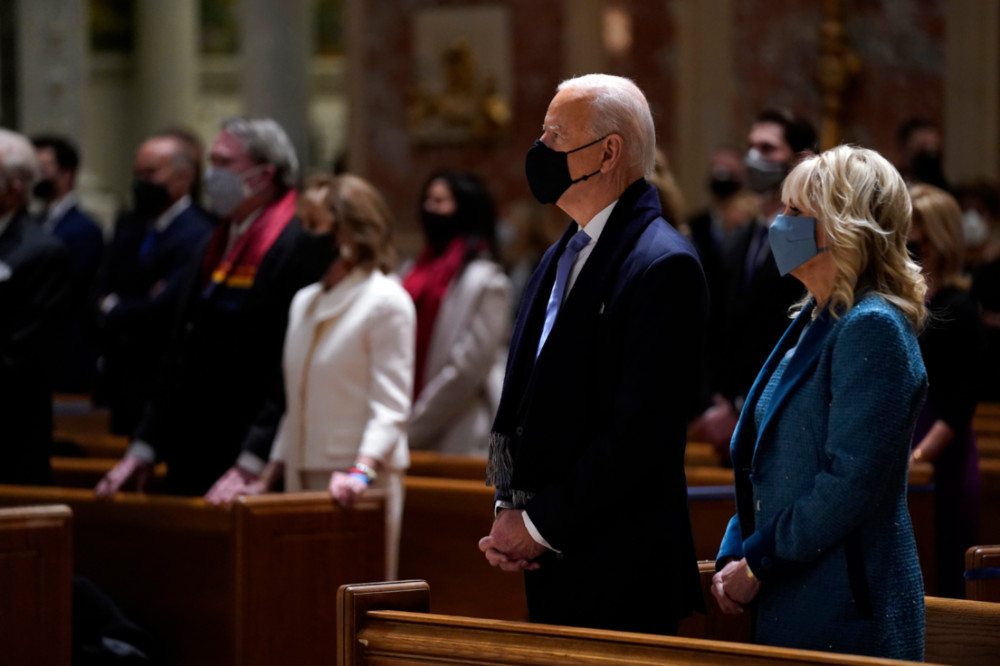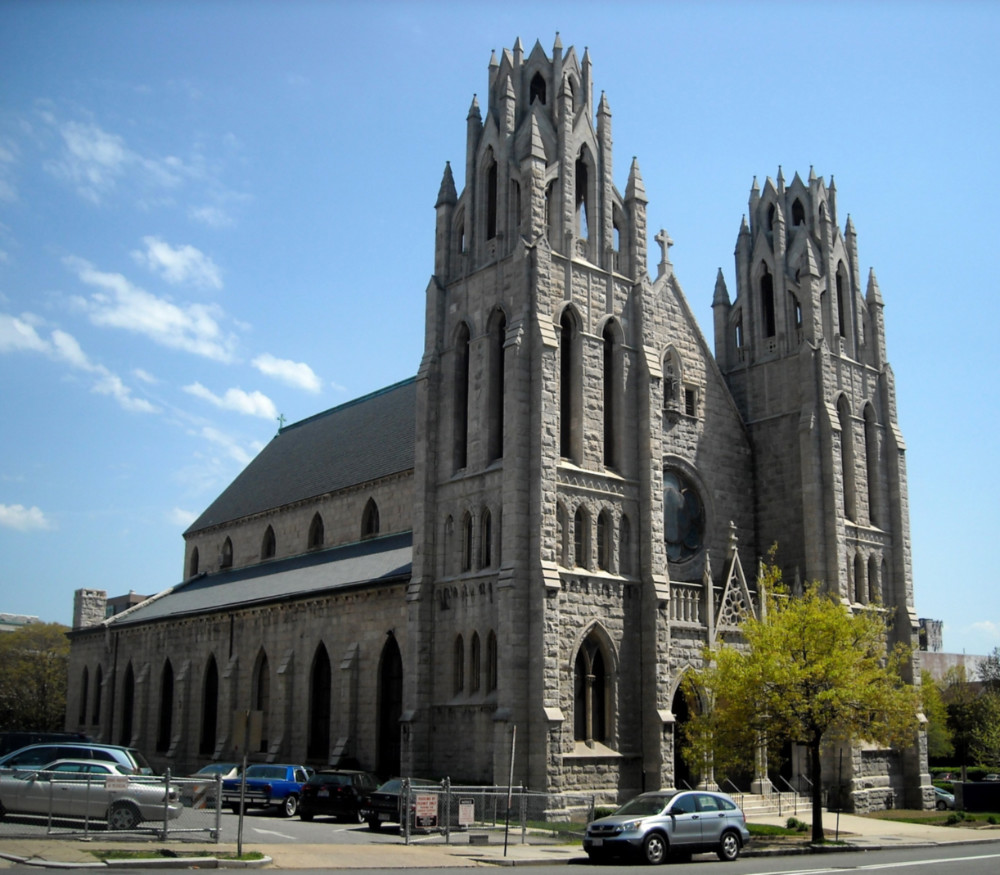
As the second ever Catholic President takes office in the US, JACK JENKINS, of Religion News Service, looks at Catholic influencers in Washington, DC…
Washington DC, US
RNS
When President Joe Biden took the oath of office on Wednesday, he became only the second Catholic president in US history.
But when he marched off the Capitol grounds later in the day, he re-entered a much larger group: a peculiar, hyper-political faith community that makes the nation’s capital one of the most active and ardent Catholic centres.

President-elect Joe Biden is joined his wife Jill Biden as they celebrate Mass at the Cathedral of St Matthew the Apostle during Inauguration Day ceremonies on Wednesday, 20th January, 2021, in Washington. PICTURE: AP Photo/Evan Vucci.
Those believers who live in what locals call “the District” are a complex, multi-layered web of cardinals and other churchmen, politicians, professors and everyday Catholics who also happen to regularly rub elbows with the most powerful people on the planet. It’s a community Biden has known for decades, but one that already looks markedly different from when he left the Vice President’s official home, Number One Observatory Circle, to return to his home state of Delaware just four years ago.
Washington’s Catholicism is in part a reflection of the country: As the largest Christian denomination, with some 51 million members in the US, it’s statistically fitting that at least a quarter of Congress (around 30 per cent this go-round, per Pew Research ) usually claims a Catholic identity. Several recent House speakers – Nancy Pelosi, John Boehner and Paul Ryan – are Catholic. Their shared beliefs were on full display when Pope Francis addressed Congress in 2015, a moment that brought Boehner to tears.
Washington’s Catholicism is in part a reflection of the country: As the largest Christian denomination, with some 51 million members in the US, it’s statistically fitting that at least a quarter of Congress (around 30 per cent this go-round, per Pew Research) usually claims a Catholic identity.
Catholicism is the majority religion on the Supreme Court, and Catholic or not, the justices, along with many notables in the capital’s judicial community, typically attend the annual Red Mass at the Cathedral of St Matthew the Apostle, celebrating those in the legal profession.
Catholic priests and sisters can often be spotted on the streets of Washington and around the Capitol, as they go about the business of public welfare with the support of the Federal Government.
“For generations, Catholicism has had a very robust presence in American public life – through its social service agencies, schools, hospitals and the like – and also as a strong presence in conversations about major public topics of the day,” said Kim Daniels, a Washington-based religious-liberty attorney and former spokesperson for the president of the US Conference of Catholic Bishops.
Conversations about topics of the day take place in different ways in a multitude of Catholic or Catholic-oriented organisations, schools and formal and informal get-togethers, some of which deepen Washington’s entrenched partisan divides.
Conservatives often flock to the annual National Catholic Prayer Breakfast, where prominent, mostly conservative Catholics such as Ryan, former Trump budget director and chief of staff Mick Mulvaney and now-deceased Supreme Court Justice Antonin Scalia have promoted Catholic political causes.
Conservative-leaning Catholics also gaggle at gatherings hosted by the Federalist Society and the Catholic Information Center, an Opus Dei-affiliated bookstore where former Attorney General Bill Barr served on the board from 2014-2017. Besides forwarding their respective missions, these organizations, multiple Catholic Washingtonians said, often function as hubs of networking and intellectual life for conservative Catholics.
Another locus for some conservative Catholics is Catholic University of America, which sits in Washington’s north-east quadrant next to the Basilica of the National Shrine of the Immaculate Conception. A major sponsor of the Catholic prayer breakfast, the school has connections that are far-reaching in the US Government and national Catholicism. Supreme Court Justice Amy Coney Barrett wrote her controversial law review article on the responsibilities of Catholic judges, raised during her confirmation hearings, with CUA’s president, John Garvey, when he was her professor at the University of Notre Dame.
“There’s a significant and often overlooked Catholic presence in the Brookland neighborhood in DC,” Garvey told Religion News Service, “anchored by Catholic University, the Basilica Shrine of the Immaculate Conception and dozens of houses of study of religious congregations, which earned it the nickname Little Rome. It’s a significant presence in our nation’s capital that demonstrates the serious commitment of Catholics to be a vital part of this nation. It’s a privilege to form a part if it.”

The Basilica of the National Shrine of the Immaculate Conception, next to Catholic University of America, in Washington. PICTURE: AP Photo/Jacquelyn Martin)
Biden, a Democrat, will have plenty of liberal Catholic company in the city. Just south of CUA is the headquarters of Network, the social justice lobby founded by Sister Simone Campbell, a longtime ally of the new President. Nestled on a bluff above the Potomac River on the city’s northwest side is Georgetown University, a celebrated Jesuit institution whose Initiative on Catholic Social Thought and Public Life is led by John Carr, a former adviser to Catholic bishops who endorsed Biden last year.
John Gehring, the Catholic program director at the liberal-leaning advocacy group Faith in Public Life, called Carr’s events “a focal point where social justice Catholics who are steeped in the church’s intellectual tradition meet to grapple with big theological and political questions in the context of our faith.”
Between these political poles is a thriving local community of Catholics living out their faith.
“Catholic Washington starts, for me, in my parish,” said Daniels. “It’s a very close-knit, active Catholic community with long-standing ties and long-standing service to the Washington community.”
A D V E R T I S E M E N T
{subscriber-ad}
Rev Ray Kemp, who grew up in Washington and works at Georgetown, agreed. He was reared among a generation of fellow white Catholics who were often passionate about their European ancestry.
“It was Irish and Italian and German and Eastern European and English,” he said. “It was a solid, hardworking, middle-class-to-lower-middle-class community of civil servants and people related to everything that supports a local and national government.”
Historic parishes dot the city. St Augustine Catholic Church, a congregation founded by emancipated African Americans near Meridian Hill Park, is often referred to as the “mother” church of black Catholics in the region. It was at St Augustine where Vice President Kamala Harris, while studying to get her bachelor’s degree at Howard University in the 1980s, reportedly used to slide into the pews to listen to Gospel music and sermons by Black priests.
Kemp pointed to crucial subsets of Washington’s Catholic core, including a growing population that hails from parts of Central and South America. Kemp recounted that Sean O’Malley, now a cardinal in Boston, used to work closely with the community when he lived in Washington, and several noted the importance of parishes such as Our Lady Queen of the Americas in northwest Washington.
As in any diocese, these local communities regularly interact with prominent church hierarchs. When Cardinal Wilton Gregory, the first African American cardinal in Catholic history, visited St Augustine in 2019 as the newly minted archbishop of Washington, he reportedly declared: “I stand on holy ground.”

Saint Augustine Catholic Church (est 1858), located at the intersection of 15th and V Streets in the U Street Corridor of Washington, DC. PICTURE: AgnosticPreachersKid/Creative Commons
Unlike other dioceses, those local interactions are often removed only a few degrees from positions of global significance. This effect will likely be magnified under a Catholic president. Gregory and Biden are reportedly already in regular conversation, so much so that the cardinal delivered the opening remarks at the first event of Biden’s inauguration schedule: a memorial service Tuesday evening to mourn those who have died as a result of the pandemic caused by the coronavirus.
Some of those interactions are just part of the daily routine.
“I happened to get my hair cut by the same barber as the Apostolic Nuncio,” Kemp said, referring the Vatican’s ambassador to the United States.
It remains to be seen how all these pieces will interact under Biden. For his part, Gregory told RNS in December that he hopes to have a relationship with Biden that “allows us to have a serious conversation, knowing full well that there are issues that he and I will be diametrically opposed [on], but hopefully also being able to capitalise on issues that we can advance together.”
Catholic Washington will be watching to see whether conservative Catholics – in Congress, the Supreme Court or the pews – who disagree with the new president on several core issues will offer that cooperation.
It’s sure that for all their differences, Catholics in Washington will continue to gather, worship and partake in the Eucharist. For Kemp, a Catholic Washington that worships together despite all its complicated layers is more than a democratic phenomenon.
“It’s home,” he said.





